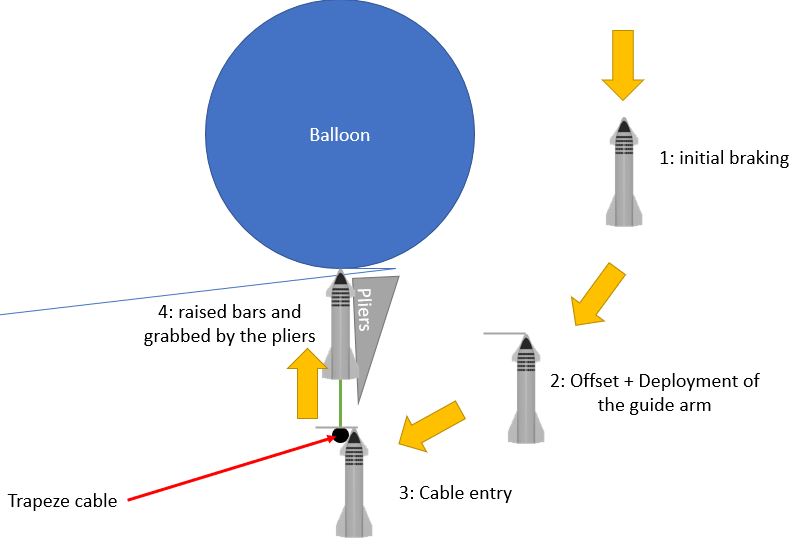250t empty, 300 passengers, 70m long, 9m in diameter
Earth date: 11:43 p.m. Tuesday January 16, 2142
Venusian date: 8:26 Croday 45 advanae 61
Location: 5,000km above Venus
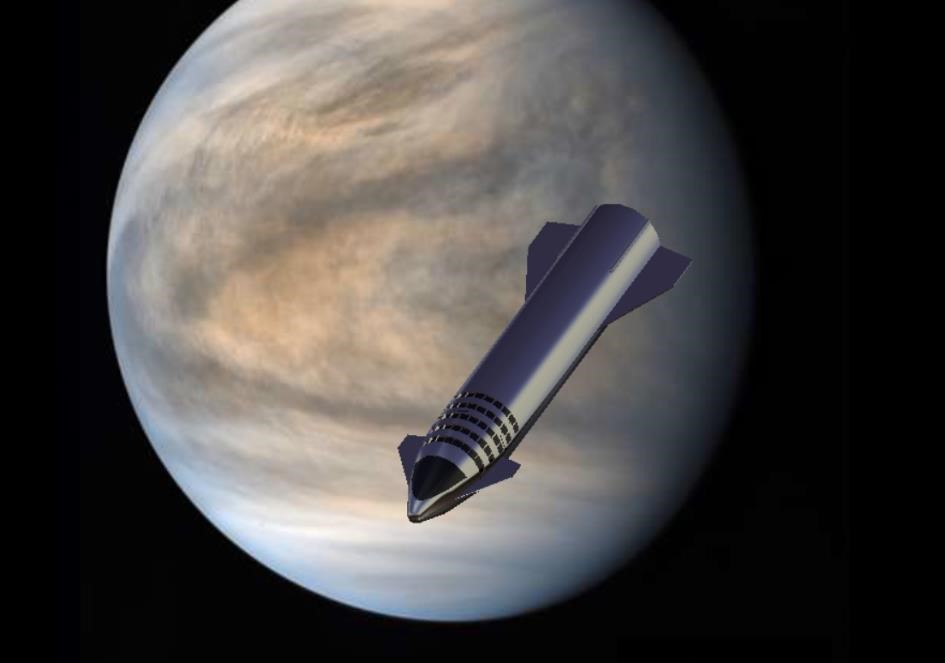
With the years of space colonization, the term starship, which designates the upper part of a particular launcher, has become a generic term for all vehicles acting as a living module, upper floor and shuttle, whatever the manufacturer. In the early days of manned interplanetary exploration, spacecraft set off on their own and served as habitat for early settlers during interplanetary flights. The one you are riding in today is quite different. It is designed to carry around 300 people for journeys of just a few hours between a planet and an orbiting destination. You have already used it when leaving Earth to join the orbiting Bifröst and it will now lead you from Bifröst to a colony in the clouds of Venus.
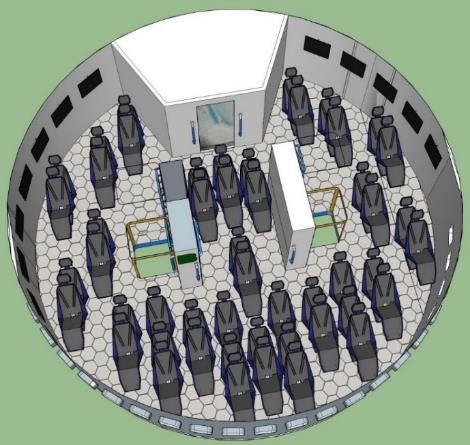
The interior of this ship resembles a warehouse of seats on rails on several levels. As you float through this maze you make your way to your seat that you have recognized in advance over the past few days and started to strap yourself on. A flight attendant hovers from seat to seat to check that everyone is properly strapped in as the last passengers enter and find their seats. You take advantage of those few minutes to try and look through nearby portholes. Between the seats you cannot make out the central tube and another starship, also in the embarkation phase. To break up the feeling of being locked away in this overcrowded cabin, screens in front of you display images from a camera in the front and rear of the ship. A final screen shows you the trajectory of your ship, which will pass its periapsis just above the atmosphere in about twenty minutes. As the last passages have settled in, the flight attendants close the access hatch and then strap themselves to their seats. At this point, your starship will detach and slide away from the center tube sliding being the two dwelling wheels. The starship that you can see through the window is located between the wheel and the center tube in a space too narrow to come out on your own. Its support therefore rotates 90 ° around the axis of the ship in order to take the place you occupied a few seconds ago to finally detach and follow you.
Going back you can see the Bifröst in its entirety for the first time since leaving Earth. The two large wheels you live in will slow down to decrease the gyroscopic effect and make this huge ship more maneuverable. Indeed as you move towards Venus, the Bifröst will ignite these cryogenic engines during a brief impulse which will allow it to place itself in a very elliptical orbit. For 15 months, it will remain in this orbit to receive maintenance, overhaul and replenishment visits. At the end of this period, starships full of travelers will moor there, and a little boost from the engines will be enough to shift from the eccentric holding orbit to the transfer path to Earth.
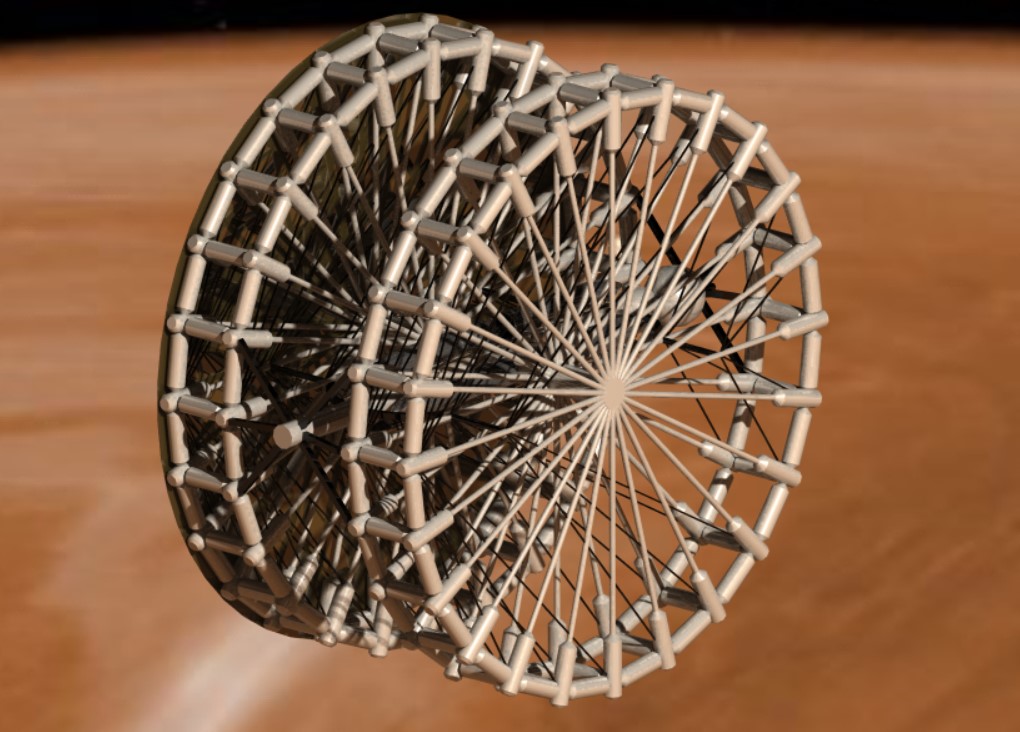
Aerobraking
Arrived at three center meters from the Bifröst, your starship suddenly turns on itself and now points straight towards Venus its heat shield pointed towards the sun. As you admire the clouds passing in front of you, a series of jolts lets you know that the control engines continue to alter course. You get confirmation on the tracking screen, as the Bifröst continues on its path and passes above the atmosphere, your new path will take you to the upper layers. This passage through the atmosphere called airbrake is intended to decrease your speed, for now so high that it would send you back into interplanetary space if nothing was done. After a few minutes, the nose camera begins to film the horizon, allowing you to see a bluish layer held above the yellowish cloud layers. This is when your starship swings 180 degrees around its axis so that its heat shield is on the atmosphere side.

Through the portholes and the cameras, you see a reddish then yellow glow forming under the belly of the other starship which one leaves the Bifröst. This same glow, soon reminiscent of flames, quickly hides the camera before climbing back up to the porthole. Simultaneously, the ship will vibrate and you push yourself against the harness that holds you in the seat. After a few minutes this feeling of being overwhelmed will peak as the flames completely surround your ship. All acceleration forces, flames and vibrations gradually diminish as you leave the atmosphere. Above you another starship has already emerged as you return the portholes to Venus and you see another ship continuing its atmospheric reentry in a trail of fire. This separation of the fleet is due to the various destinations targeted. A starship slated to land on colonies close behind the atmospheric entry point continues its airbrake until it reaches its destination. Unlike joining a colony in front of or below the atmospheric entry point, the airbrake is weak in order to achieve the objective in the next orbit. You are in an intermediate case in a relatively circular orbit which leaves you a few more minutes of weightlessness before attacking the final atmospheric reentry.
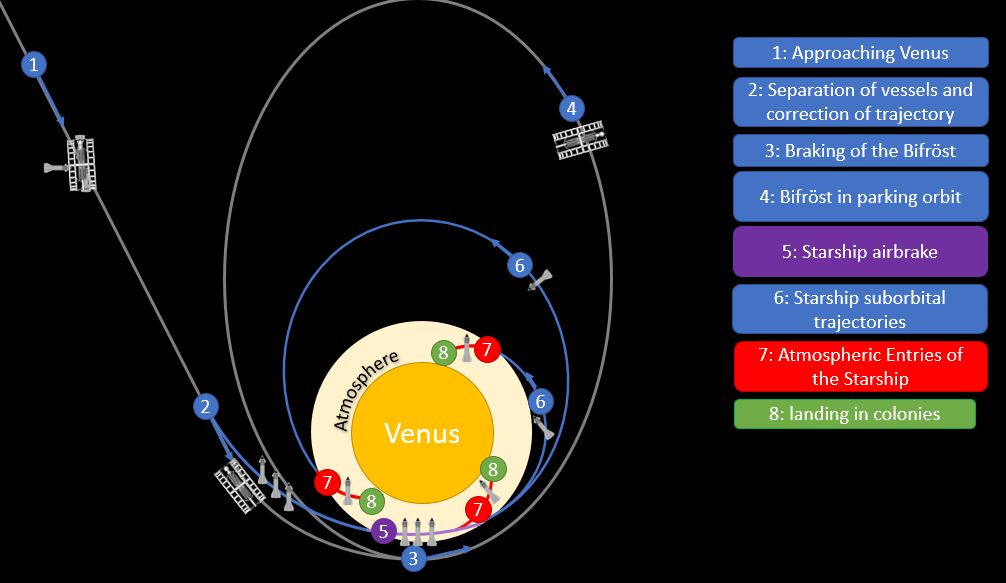
Enter, Descent and Land (EDL)
The start of this re-entry is similar to aerobraking but the deceleration becomes more and more violent to the point that you have difficulty breathing and you feel dizzy due to the difficulty of the blood rising to your brain. Even though the re-entry of the atmosphere is less violent than at the start of space air, the democratization of interplanetary travel has lowered the criteria for physical admission and some of the people around you will pass out under such a load. Fortunately for them the situation calms down quickly when the starship starts to hover like an airplane. However, Venusian gravity similar to Earth’s gravity remains a constraint after three months shift to weaker man-made gravity.
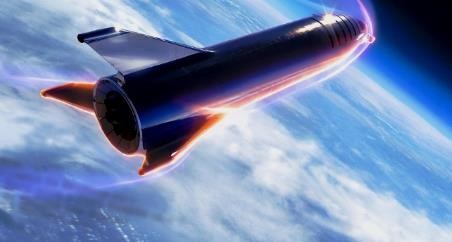
As you passed behind this balloon, the starship’s engines suddenly kick in to slow the fall, pushing you back against your seat. While slowing down, the ship begins to shift under the balloon where you see a cable held by two arms, the famous trapeze. On the screens you see an arm (known as guide arm) deploying on the starship and eventually resting on the cable. As the vibrations continued, the starship eventually moved only horizontally so that the facing guide arm slid the trapezoid cable into a notch in the nose of the vessel. The motors gradually decrease in power to test the cable support and then shut down completely leaving you in complete calm. While the ship is still rocking, the screen in front of you displays the message “Successful landing, Welcome to Venus”. Like many around you, you open the visor of your helmet and begin to shake hands with those sitting near you in a collective euphoria. This cable laying procedure was designed to overcome the lack of a solid surface in the Venusian colonies. It is also developing on Earth with the arrival of suborbital intercontinental transport to provide a landing area in front of coastal cities without a large stabilized barge.
